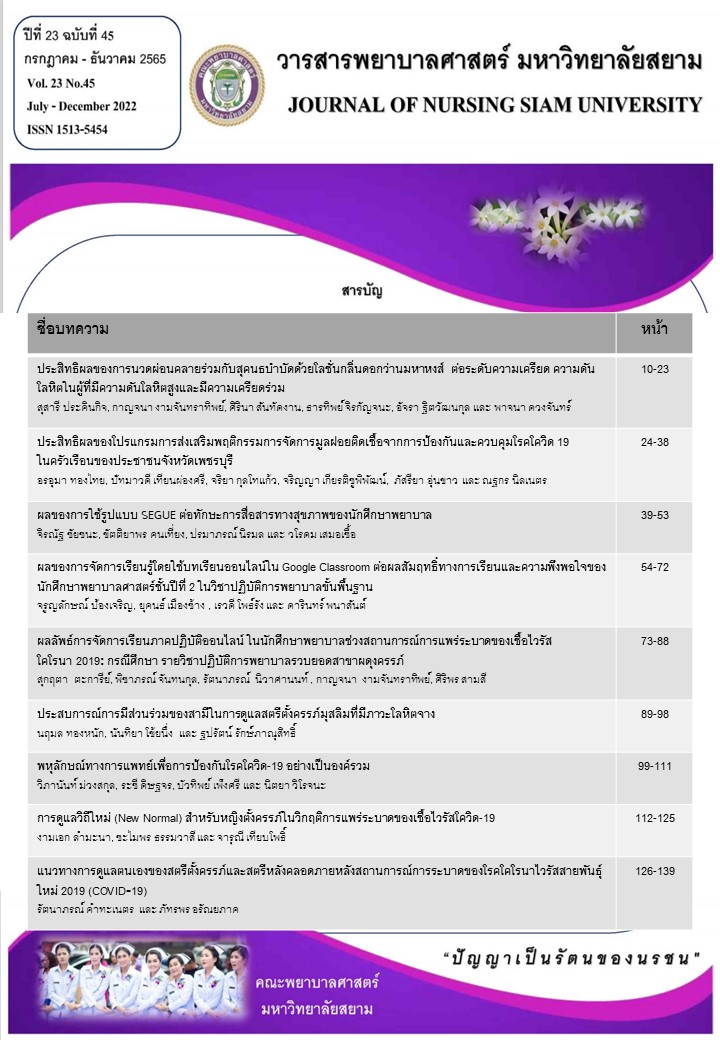พหุลักษณ์ทางการแพทย์เพื่อการป้องกันโรคโควิด-19 อย่างเป็นองค์รวม
-
คำสำคัญ:
พหุลักษณ์ทางการแพทย์, โรคโควิด-19, การดูแลแบบองค์รวมบทคัดย่อ
พหุลักษณ์ทางการแพทย์ เป็นการแสดงให้เห็นถึงความหลากหลายของระบบสุขภาพชุมชนที่มีอยู่ในสังคม จากการระบาดของโรคโควิด-19 นั้น พบว่ามีการดูแลสุขภาพตามแนวคิดพหุลักษณ์ทางการแพทย์มาใช้ในการป้องกันโรคโควิด-19 ประกอบด้วย 1. ระบบสุขภาพภาคประชาชนในการป้องกันโรคโควิด-19 อย่างเป็นองค์รวมได้แก่ 1) การปฏิบัติตัวในชีวิตประจำวัน 2) แบบแผนปฏิบัติตัวในช่วงวาระพิเศษของวัยและชีวิต 3) ยาสมุนไพร ซึ่งเป็นการดูแลสุขภาพภายใต้ชีวิตวิถีใหม่ มุ่งเน้นการส่งเสริมสุขภาพทางด้านร่างกาย จิตใจ และสังคม 2. ระบบการแพทย์พื้นบ้านในการป้องกันโรคโควิด-19 อย่างเป็นองค์รวม เป็นการดูแลสุขภาพภายใต้ความเชื่อ พิธีกรรม และวัฒนธรรมท้องถิ่นเพื่อสร้างความเชื่อมั่นและคลายความกังวลต่อโรคโควิด-19 ให้กับประชาชนซึ่งเป็นการเยียวยาด้านจิตใจและจิตวิญญาณ และ 3. ระบบสุขภาพภาควิชาชีพในการป้องกันโรคโควิด-19 อย่างเป็นองค์รวม เป็นระบบสุขภาพที่มีบุคลากรทางวิชาชีพเป็นผู้ให้การดูแลรักษาในทุกมิติทางสุขภาพและทุกระดับของการให้บริการทางสุขภาพ ซึ่งการแพทย์ทั้ง 3 ระบบมีส่วนช่วยส่งเสริมและป้องกันโรค ดังนั้น การสร้างเสริมให้บุคลากรทางการแพทย์ โดยเฉพาะพยาบาลวิชาชีพมีความรู้ในการดูแลสุขภาพเพื่อป้องกันโรคอย่างเป็นองค์รวม โดยอาศัยแนวคิดพหุลักษณ์ทางการแพทย์ จึงเป็นสิ่งสำคัญเพื่อให้การดูแลสุขภาพประชาชนในการป้องกันโรคโควิด-19 ได้อย่างสมบูรณ์มากยิ่งขึ้นต่อสถานการณ์การระบาดของโรคอุบัติใหม่ในปัจจุบัน
เอกสารอ้างอิง
กรมสุขภาพจิต. (2563). New Normal ชีวิตวิถีใหม่. สืบค้น 27 เมษายน 2565, จากhttps://www.dmh.go.th/news/view.asp?id=2288#.
กระทรวงสาธารณสุข. (2565). เกณฑ์การพิจารณาโรคโควิดเป็นโรคประจำถิ่น. สืบค้น 25 เมษายน 2565, จากhttps://web.facebook.com/informationcovid19/photos/a.106142991004034/494419312176398/?type=3&_rdc=1&_rdr.
โกมาตร จึงเสถียรทรัพย์. (2549). พหุลักษณ์ทางการแพทย์กับสุขภาพในมิติสังคมวัฒนธรรม พิมพ์ครั้งที่ 1. กรุงเทพมหานคร: ศูนย์มานุษยวิทยาสิรินธร
ชนิดา มัททวางกูร. (2557). จุดเปลี่ยนจุดยืนและจุดเชื่อมประสานภูมิปัญญาการแพทย์พื้นบ้านกับระบบสุขภาพชุมชน. (วิทยานิพนธ์ปรัชญาดุษฎีบัณฑิต). นครปฐม: มหาวิทยาลัยเกษตรศาสตร์.
ชัยวัฒน์ งามปิยะสกุล, คณิสร แก้วแดง, นวพร ไพรวัลย์สถาพร และวันดี บุญเกิด. (2559). ผลของการใช้เทคนิค SKT 3 “นั่งยืด-เหยียดผ่อนคลายประสานกาย ประสานจิต” ต่อจำนวนเม็ดเลือดขาวชนิดซีดีสี่ ฮีโมโกลบิน เม็ดเลือดขาวทั้งหมด และนิวโทรฟิล ของผู้ติดเชื้อเอชไอวีเด็กและวัยรุ่น. วารสารศูนย์การศึกษาแพทยศาสตร์คลินิก โรงพยาบาลพระปกเกล้า, 33.(4): 276-287.
เชาวลักษณ์ ฤทธิสรไกร. (2554). สังคมศาสตร์สาธารณสุข. พิมพ์ครั้งที่ 3. สงขลา: ศูนย์หนังสือมหาวิทยาลัยทักษิณ.
ดวงแก้ว ปัญญาภู. (2564). บทบาทของสมุนไพรและยาแผนไทยในสถานการณ์โรคโควิด-19 ระบาด.พิมพ์ครั้งที่ 1. กรุงเทพ: บริษัท เอส.บี.เค. การพิมพ์ จำกัด; 2564.
ธิดารัตน์ วงศ์จักรติ๊บ, ภาณุวัฒน์ สกุลสืบ และ ทัตพิชา สกุลสืบ. (2564). “พิธีกรรมการป้องกันโรคโควิด 19 ของชุมชนบ้านกิ่วท่ากลาง-ท่าใต้ หมู่ที่ 7 ตำบลบ้านกิ่ว อำเภอแม่ทะ จังหวัดลำปาง.”วารสารมังรายสาร สถาบันภาษาและวัฒนธรรมนานาชาติ มหาวิทยาลัยราชภัฏเชียงราย, 9(1): 65-79.
ธีรยุทธ รุ่งนิรันดร. (2563). การดูแลสุขภาพจิตช่วงการระบาดของโควิด-19. สืบค้น 15 พฤษภาคม 2565, จากhttps://www.dmh.go.th/news/view.asp?id=2368.
ปารณัฐ สุขสุทธิ์. (2551). “พหุลักษณ์ระบบสุขภาพในชุมชน.” ใน โกมาตร จึงเสถียรทรัพย์ และคณะ (บรรณาธิการ). วัฒนธรรมสุขภาพกับการเยียวยา แนวคิดทางสังคมและมานุษยวิทยาการแพทย์. พิมพ์ครั้งที่ 3. นนทบุรี: สำนักวิจัยสังคมและสุขภาพ.
มาโนช หล่อตระกูล, ธนิตา หิรัญเทพ และนิดา ลิ้มสุวรรณ. (2555). ตำราพฤติกรรมศาสตร์ทางการแพทย์. พิมพ์ครั้งที่ 1. กรุงเทพมหานคร: ภาควิชาจิตเวชศาสตร์ คณะแพทยศาสตร์ โรงพยาบาลรามาธิบดี มหาวิทยาลัยมหิดล.
มณีรัตน์ องค์วรรณดี. (2564). สรุปสาระสำคัญจากการบรรยายเรื่องการบริหารจัดการเมืองในสภาวะการแพร่ระบาดของ Covid – 19. สืบค้น 23 เมษายน 2565, จาก https://imd.nmu.ac.th/summary-questions-about-air-purifiers-and-covid-19-th/.
วิชัย โชควิวัฒน, สุวิทย์ วิบุลผลประเสริฐ และประพจน์ เภตรากาศ. (2553). รายงานการสาธารณสุขไทยด้านการแพทย์แผนไทยการแพทย์พื้นบ้านและการแพทย์ทางเลือก. พิมพ์ครั้งที่ 1. กรุงเทพมหานคร: สำนักวิชาการกรมพัฒนาการแพทย์แผนไทยและการแพทย์ทางเลือก กระทรวงสาธารณสุข.
สุรีย์ ธรรมิกบวร. (2555). ศิลปะกับการพยาบาลแบบองค์รวม. สืบค้น 15 พฤษภาคม 2565, จากhttp://www.nurse.ubu.ac.th/sub/knowledgedetail/Art.pdf.
สำนักงานพัฒนานโยบายสุขภาพระหว่างประเทศ. กระทรวงสาธารณสุข. (2564). รายงานผลการทบทวนผลกระทบเชิงเศรษฐกิจและสังคมจากการระบาดของโรคโควิด-19 ในระดับโลกและในประเทศไทย. สืบค้น 15 พฤษภาคม 2565, จากhttps://ddc.moph.go.th/uploads/publish/1177420210915075055.pdf.
สำนักวิจัยสังคมและสุขภาพ. (2556). สรุปสาระการเข้าร่วมประชุมเชิงปฏิบัติการ เรื่อง “สมรรถนะทางวัฒนธรรมในระบบสุขภาพ: องค์ความรู้สู่การวิจัยเชิงคุณภาพ, 18-21 พฤศจิกายน 2556. สืบค้น 15 พฤษภาคม 2565, จากhttps://kb.hsri.or.th/dspace/bitstream/handle/11228/4042/hs2122.pdf?sequence=3&isAllowed=y.
อุไร หัถกิจ และประภาพร ชูกำเนิด. (2558). ปัจจัยที่มีความสัมพันธ์กับการปฏิบัติการพยาบาลที่ผสมผสานภูมิปัญญาตะวันออก. วารสารพยาบาลสงขลานครินทร์, 35: 1-14.
Kleinman, A. (1980). Patients and Healers in the Context of Culture: An Exploration of the Borderland between Anthropology, Medicine, and Psychiatry. Berkeley: University of California Press.
WHO. (2020). WHO Director-General's opening remarks at the media briefing on COVID-19 - 11 March 2020. Retrieved 29 October 2022, from https://www.who.int/director-general/speeches/detail/who-director-general-s-opening-remarks-at-the-media-briefing-on-covid-19---11-march-2020.
WHO. (2021). Coronavirus disease (COVID-19): How is it transmitted?. Retrieved 23 April 2022, from https://www.who.int/news-room/questions-and-answers/item/coronavirus-disease-covid-19-how-is-it-transmitted
WHO. (2022). Advice for the public: Coronavirus disease (COVID-19). Retrieved 15 May 2022, from https://www.who.int/emergencies/diseases/novel-coronavirus-2019/advice-for-public.
WHO. (2022). Coronavirus disease (COVID-19). Retrieved 29 October 2022, from https://www.who.int/health-topics/coronavirus#tab=tab_1.
ดาวน์โหลด
เผยแพร่แล้ว
รูปแบบการอ้างอิง
ฉบับ
ประเภทบทความ
สัญญาอนุญาต
ลิขสิทธิ์ (c) 2022 วารสารพยาบาลศาสตร์ มหาวิทยาลัยสยาม

อนุญาตภายใต้เงื่อนไข Creative Commons Attribution-NonCommercial-NoDerivatives 4.0 International License.
เนื้อหาและข้อมูลที่เผยแพร่ในวารสารพยาบาลศาสตร์ มหาวิทยาลัยสยามถือเป็นข้อคิดเห็นและความรับผิดชอบของผู้นิพนธ์บทความโดยตรง
บทความ เนื้อหา ข้อมูล รูปภาพ ฯลฯ ที่ได้รับการเผยแพร่ในวารสารพยาบาลศาสตร์ มหาวิทยาลัยสยาม ถือเป็นลิขสิทธิ์ของวารสารพยาบาลศาสตร์ มหาวิทยาลัยสยาม หากบุคคลหรือหน่วยงานใดต้องการนำทั้งหมดหรือส่วนหนึ่งส่วนใดไปเผยแพร่หรือเพื่อกระทำการใด ๆ จะต้องอ้างอิงวารสารพยาบาลศาสตร์ มหาวิทยาลัยสยามทุกครั้ง



